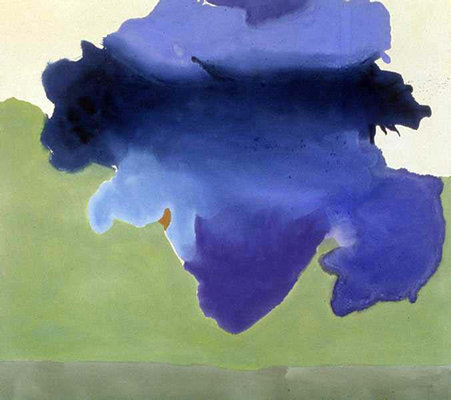Helen Frankenthaler, The Bay
At first glance, it’s hard to know what to make of Helen Frankenthaler’s heaving, atmospheric painting, The Bay.

We see an imposing fluid blue promontory suspended in front of us. Its colors ranging from violet to indigo run into one another with a clear zone of navy near the top of the canvas that draw our eyes up to it. The blurring of the colors gives an immediate sense of the artist’s process: paint poured onto the canvas when it was wet. We can almost watch as the blues meld into one another during this early stage giving the image its blurred and smooth finish.
Is its subject what the title suggests—a landform of some kind with certain emblematic associations? Is the swelling amorphous blue mass floating amid that moss green and cream border meant to stand for something beyond itself? With many Abstract Expressionist paintings of the 1950s and 60s, it’s important not to get too caught up with possible social and historical contexts and biography, but to focus on what’s before us—the physical elements of the work itself because those elements can tell us so much about the painting.
Soak-stain
Frankenthaler’s approach here was to use a soak-stain method with diluted acrylic paint. Acrylics gave her more flexibility with viscosity and movement than oils, and allowed her more control as she poured that thinned paint onto the taut unprimed canvas so that it would get absorbed into the weave of the fabric. As a substitute for the action of the brush, Frankenthaler would lift the canvas and tilt it at various angles so that the paint would flow across the surface. She had to account for gravity and the ebb and flow of a liquid across a flat surface, so a fascinating aspect of Frankenthaler’s method is the blend of the artist’s control paired with the unpredictability of the forces of nature.
Frankenthaler was inspired by the drip method of Jackson Pollock who began painting on the floor in the late 1940s, but she knew she wanted to work differently. Pollock and other artists such as de Kooning and Franz Kline had made the painted gesture too famous and recognizable by the early 1950s. In 1952, at the age of 23, Frankenthaler’s experiments lead her to produce her first major painting, Mountains and Sea, an expansive luminous depiction of the landscape of Nova Scotia, where she’d recently taken a holiday.[1]

- Farisa Khalid, "Helen Frankenthaler, The Bay," in Smarthistory, August 9, 2015, accessed February 21, 2023, https://smarthistory.org/frankenthaler-the-bay/ ↵

